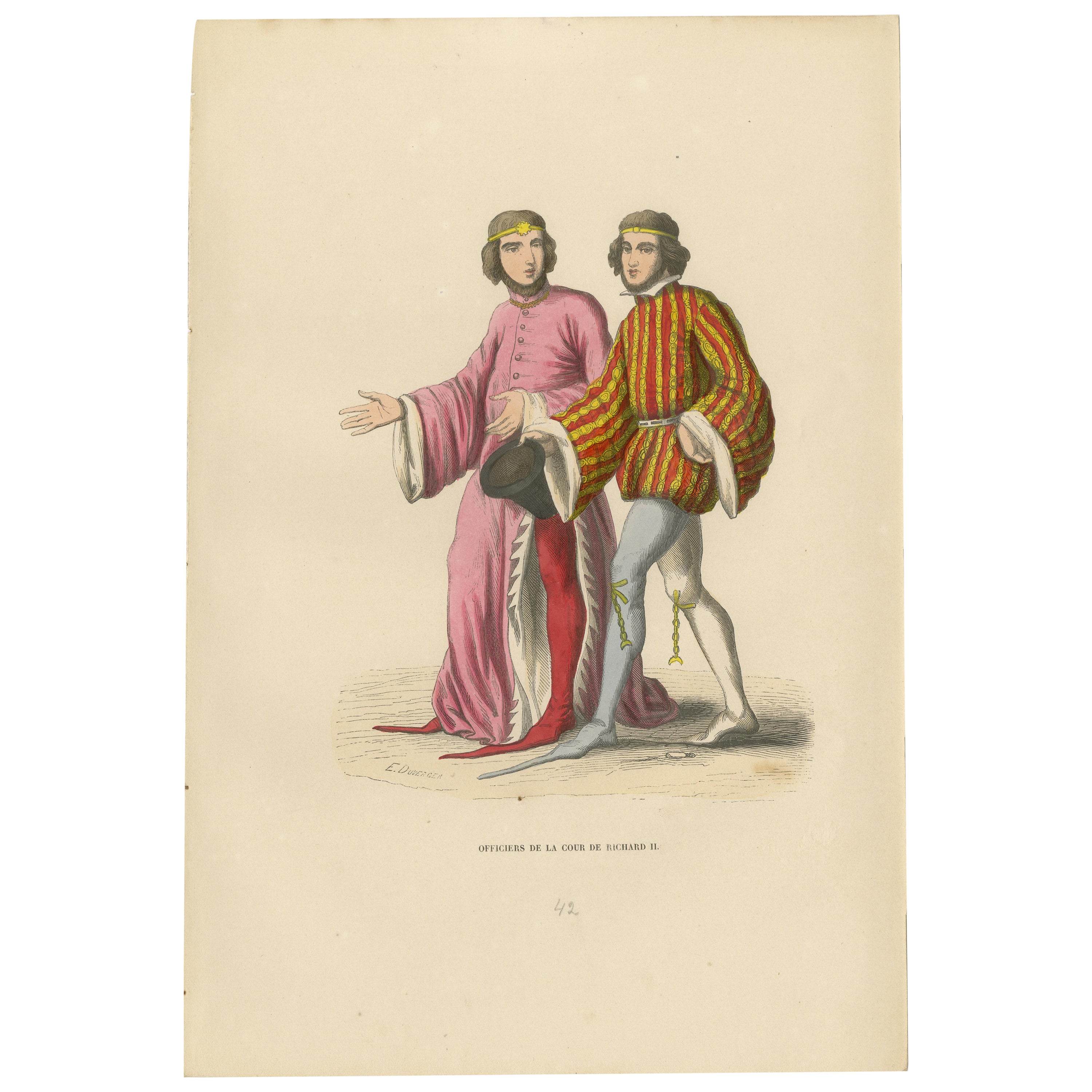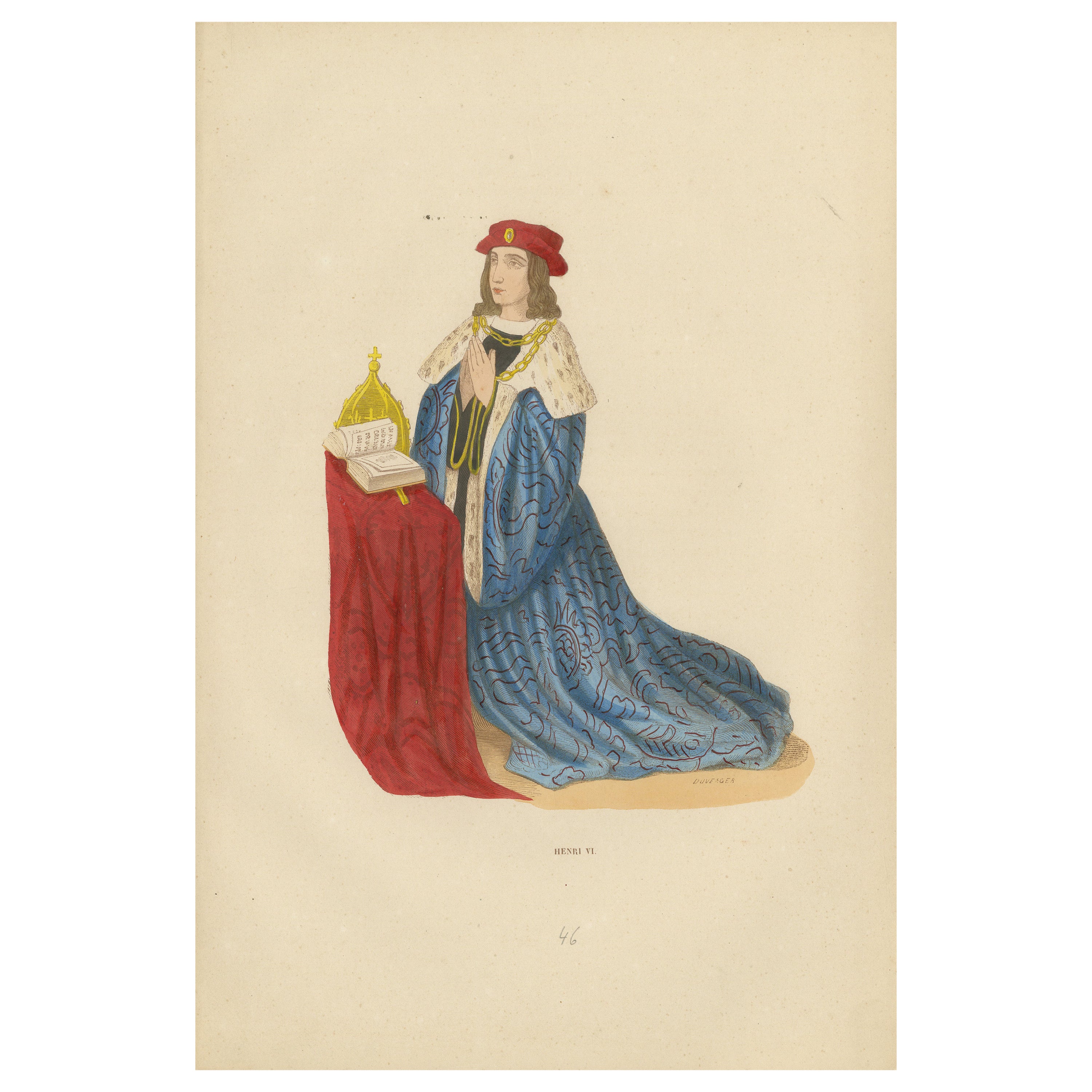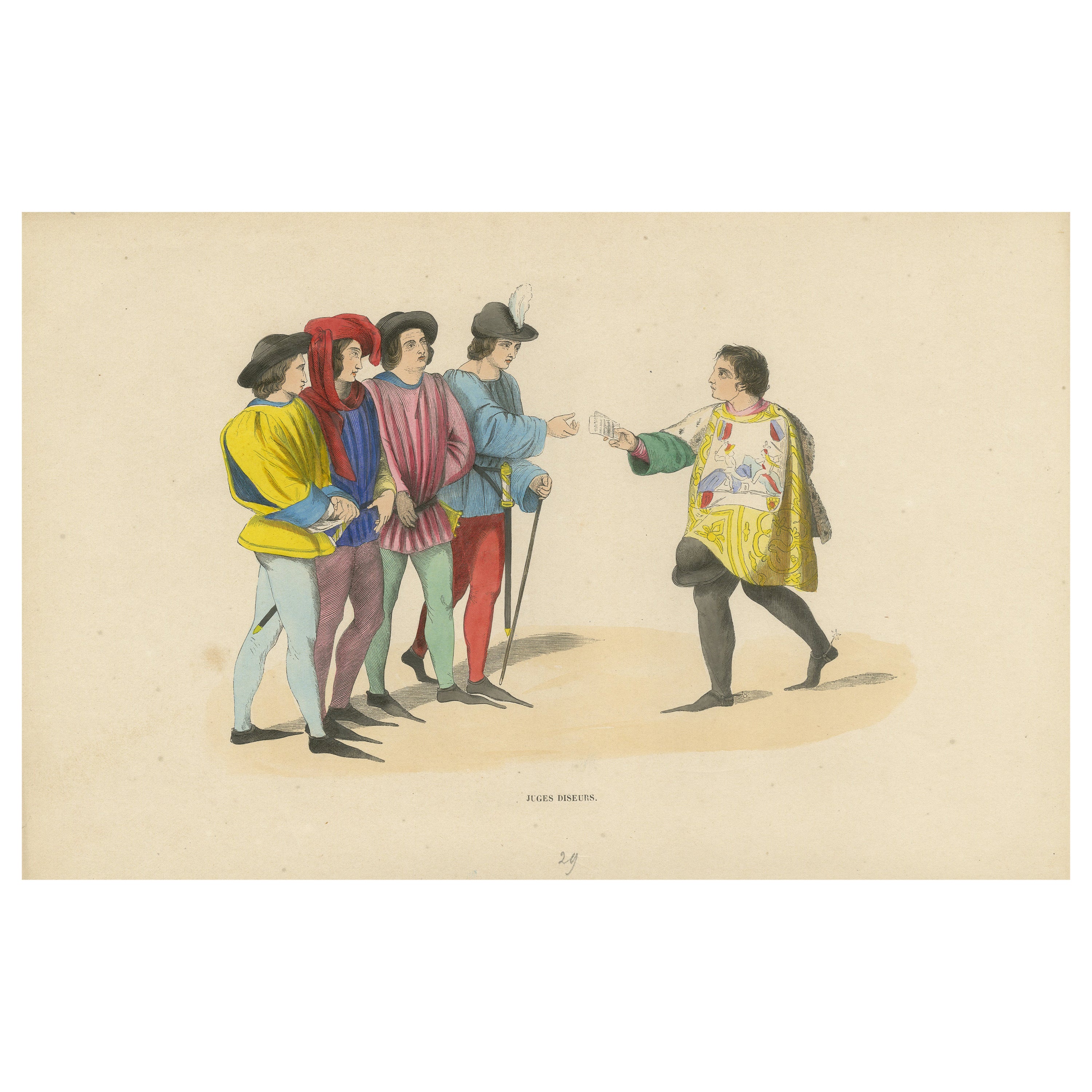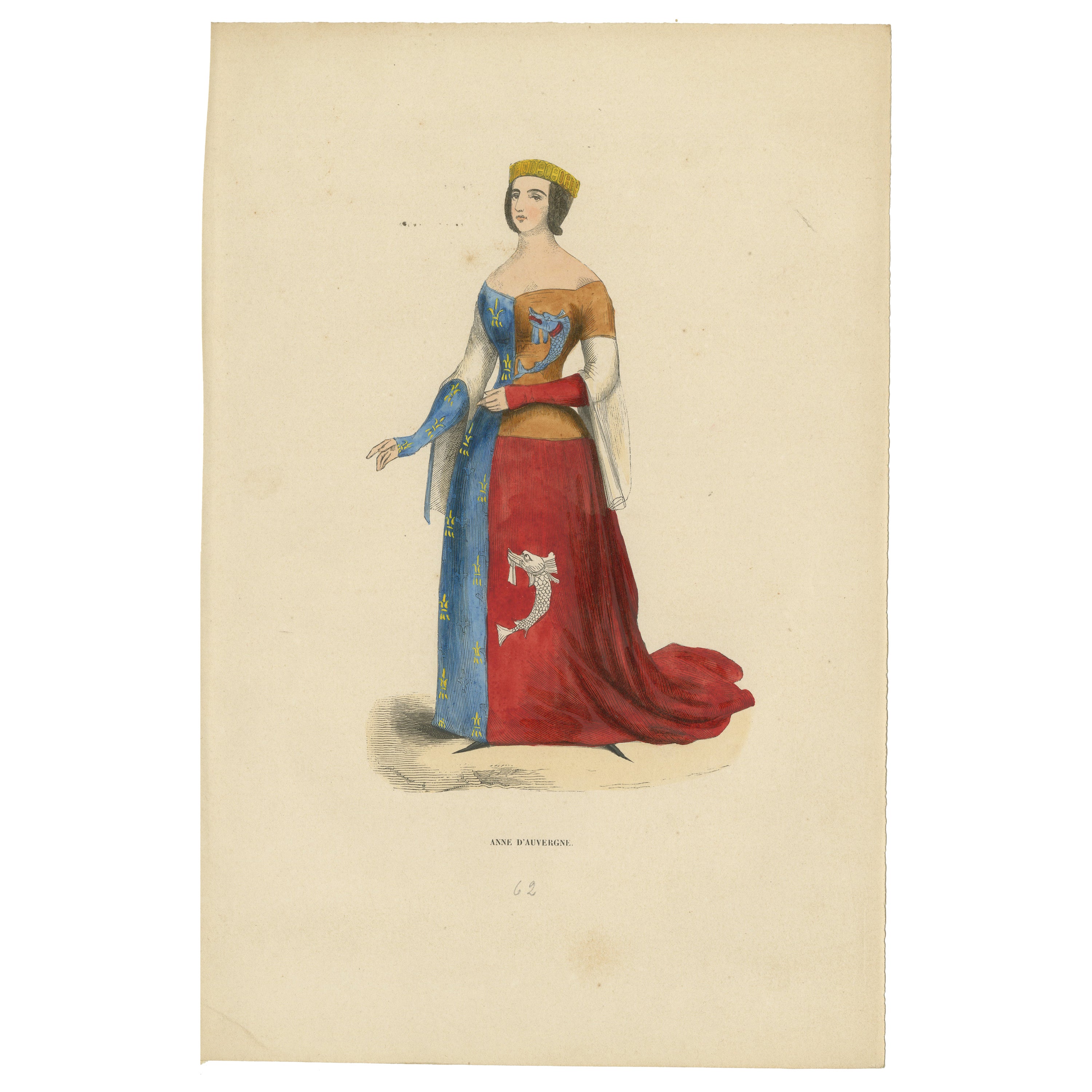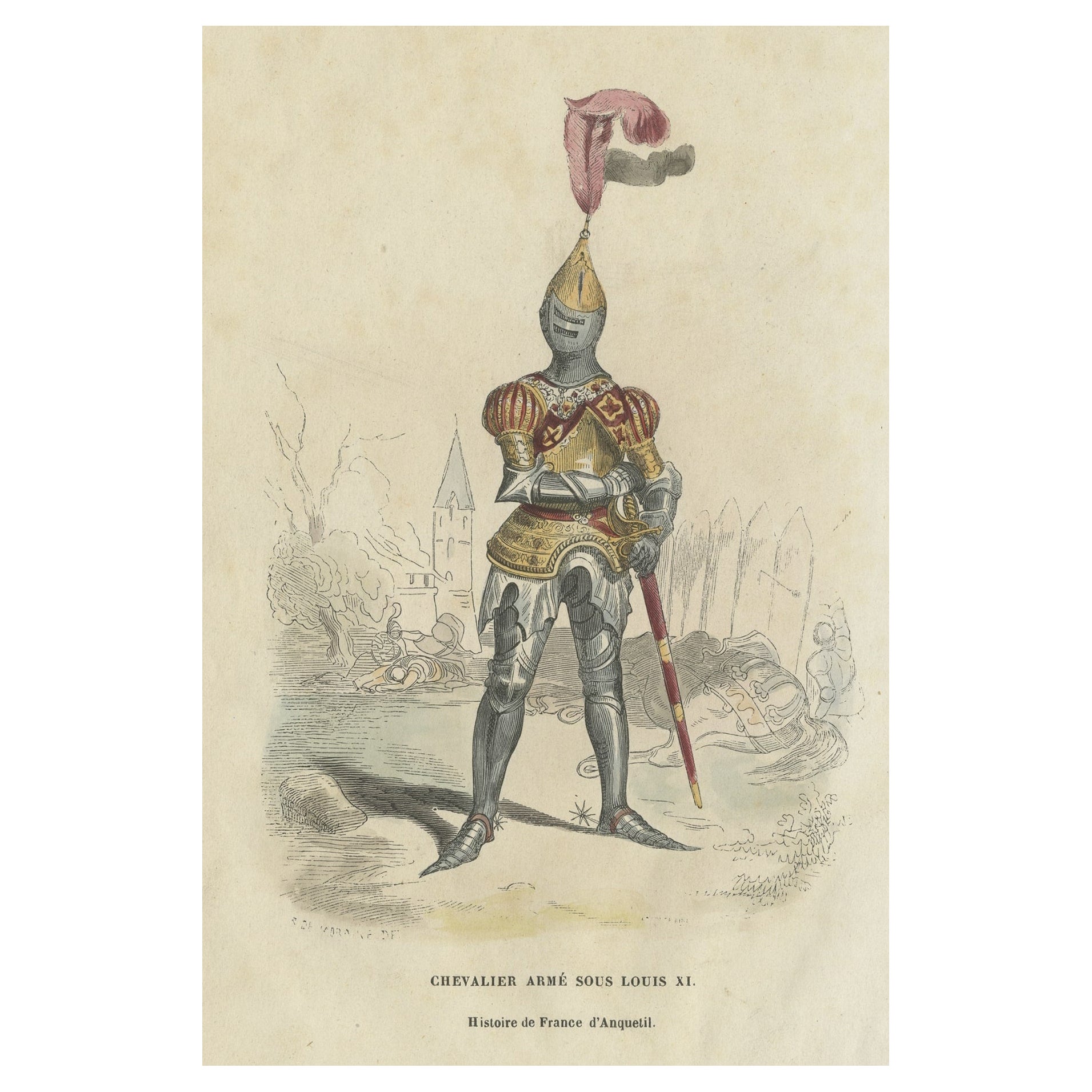Items Similar to John Sitsylt, the Heraldic Knight in an Original Hand-Colored Lithograph of 1847
Want more images or videos?
Request additional images or videos from the seller
1 of 10
John Sitsylt, the Heraldic Knight in an Original Hand-Colored Lithograph of 1847
About the Item
Title: "John Sitsylt, the Heraldic Knight: An Illustrated Plate from 'Costume du Moyen Âge'"
Description: This 19th-century lithograph, part of the "Costume du Moyen Âge" collection, displays John Sitsylt, a knight garbed in the elaborate heraldic tradition. His armor, a mix of mail and plate, is indicative of the era's military attire, designed for both protection and mobility. The surcoat worn over his armor features a blue and gold striped pattern, each stripe bearing a lock motif, possibly signifying his house or the lord he serves. The same pattern is echoed on the large shield he carries, a common practice to help identify knights on the battlefield.
He stands holding a tall, checkered flag with the same heraldic locks, which may represent his role as a standard-bearer, a position of honor and significance in medieval warfare. The flag's design mirrors the pattern on his surcoat and shield, reinforcing the importance of heraldic symbols in establishing identity and allegiance.
His helmet, a simple yet effective design, allows for visibility while protecting his head. The red and white flowing cape adds a touch of regality and distinction, highlighting his status. His posture, with one hand on the shield and the other gripping the flagpole, is a stance of readiness and pride.
The attention to detail in the lithograph is meticulous, from the chainmail's texture to the fabric's folds, capturing the material's essence. It tells a story of medieval chivalry, the significance of heraldry, and the knight's esteemed position within the social and military hierarchy of the Middle Ages. It is a window into the past, portraying the knight not just as a warrior, but as a symbol of his time, adorned with the emblems of his heritage and duty.
This is an illustration of a soldier from Venice, known as a "Soldat Vénitien." The image is likely from a historical or military costume book, detailing the dress and equipment of various figures throughout history.
The soldier is depicted wearing a conical helmet with a protective nose guard, common in some European regions during the medieval period. His attire is elaborate, featuring a patterned tunic with what appears to be embroidered or woven designs, possibly representing his rank, unit, or city-state allegiance. The tunic is worn over a suit of armor, with visible chainmail at the joints for flexibility.
In his left hand, he carries a tall pike or lance, a weapon that was particularly effective in formation against cavalry charges. The flag he holds in his right hand is a distinguishing feature, with its specific emblems and color likely signifying his affiliation. The fact that he carries a flag might suggest he holds a position of some significance, such as a standard-bearer, which was both an honor and a target for enemy forces.
The soldier's stern facial expression, his posture, and the direction of his gaze all contribute to a sense of solemn duty and readiness. The illustration is highly detailed, capturing the textures of the fabrics and materials, which helps to provide insight into thetechniques and styles of the period. The use of vibrant colors in the flag and tunic contrasts with the more subdued tones of his armor, highlighting the importance of heraldry and visual identification on the battlefield.
This kind of detailed illustration serves as a valuable resource for historians, reenactors, and enthusiasts interested in the military and cultural history of Venice and the broader context of European warfare. It's a snapshot of the past, bringing to life the appearance and equipment of a soldier who might have served in the Venetian military forces.
The colors have a nice glow over them. Historically, egg whites, known as glair, and sometimes egg yolk were indeed used in illumination and painting, particularly in manuscripts, to give colors a brighter appearance and to add a sheen or gloss to the work. This technique was quite common during the Middle Ages and into the Renaissance.
Egg whites can be applied as a varnish over pigments to enhance their brightness and to protect the colors. This application could make the colors appear more vivid and also add a slight glossy sheen to the surface of the image.
Egg yolk, on the other hand, was commonly used as a binding agent in paint. It forms the basis of tempera paint, a medium that was widely used before the advent of oil painting. Egg yolk helps to create a durable and long-lasting color that adheres well to various surfaces.
In the context of the print from 1847, it's less likely that egg whites or yolks were used directly on the print, as by that time, commercial printing processes would have been more advanced and less reliant on such manual methods. However, if this print is a representation of an earlier style or is meant to mimic the appearance of hand-painted manuscripts, the original artists might have employed techniques or materials that gave a similar effect to those achieved with egg-based binders and varnishes.
- Dimensions:Height: 10.63 in (27 cm)Width: 7.09 in (18 cm)Depth: 0 in (0.02 mm)
- Materials and Techniques:
- Period:
- Date of Manufacture:1847
- Condition:Good. Overal light toning and light soiling but the image itself clean and hand-colored almost 200 years ago and still in expliciet colors. Aged paper with typically warm, yellowish-brown hue, mostly around the edges. Study the images carefully.
- Seller Location:Langweer, NL
- Reference Number:
About the Seller
5.0
Platinum Seller
These expertly vetted sellers are 1stDibs' most experienced sellers and are rated highest by our customers.
Established in 2009
1stDibs seller since 2017
1,929 sales on 1stDibs
Typical response time: <1 hour
- ShippingRetrieving quote...Ships From: Langweer, Netherlands
- Return PolicyA return for this item may be initiated within 14 days of delivery.
More From This SellerView All
- Court Officers of the Reign of Richard II in an Hand-Colored Lithograph, 1847Located in Langweer, NLThe illustration features two court officers from the reign of Richard II, displaying the rich and ornate clothing typical of English courtly fashion at the end of the 14th century. ...Category
Antique 1840s Prints
MaterialsPaper
- King Henry VI in Prayer, Original Hand-Colored Lithograph, 1847Located in Langweer, NLThis print represents King Henry VI of England, depicted in a regal and contemplative pose with hands clasped in prayer. He is dressed in a blue robe with a pattern that suggests opu...Category
Antique 1840s Prints
MaterialsPaper
- The Proclamation: Judges of the Medieval Court in an Original Lithograph, 1847Located in Langweer, NLThe image depicts a group of men labeled "Juges Diseurs," which translates to "Judges Speakers" or "Speaking Judges." This term could refer to officials who were responsible for proc...Category
Antique 1840s Prints
MaterialsPaper
- Anne d'Auvergne: Nobility in Heraldic Robes, Hand-colored in 1847Located in Langweer, NLTitle: "Anne d'Auvergne: Nobility in Heraldic Robes" Description: This print represents Anne d'Auvergne, a figure of nobility, depicted in a stately and refined manner. She is clad ...Category
Antique 1840s Prints
MaterialsPaper
- Hand-Colored Lithograph of an Armed Knight under the Reign of Louis XI, ca.1860Located in Langweer, NLAntique print titled 'Chevalier armé sous Louis XI'. Lithograph of an armed knight under the reign of Louis XI. Source unknown, to be determined. Artists and Engravers: Anonymous....Category
Antique 1860s Prints
MaterialsPaper
- The Esteemed Jurist: A Magistrate's Robe in an Original Lithograph, 1847Located in Langweer, NLTitle: "The Esteemed Jurist: A Magistrate's Robe in 'Costume du Moyen Âge'" Description: This lithograph, originating from the mid-19th century "Costume du Moyen Âge" series, presen...Category
Antique 1840s Prints
MaterialsPaper
You May Also Like
- Original Antique Print of an Elephant, 1847 'Unframed'Located in St Annes, LancashireGreat image of an elephant. Unframed. It gives you the option of perhaps making a set up using your own choice of frames. Lithograph after Cpt. Brown with original hand color. Pub...Category
Antique 1840s English Folk Art Prints
MaterialsPaper
- Original Antique Print of an Eagle, 1847 'Unframed'Located in St Annes, LancashireGreat image of an eagle Unframed. It gives you the option of perhaps making a set up using your own choice of frames. Lithograph after Cpt. brown with original hand color. Publish...Category
Antique 1840s English Folk Art Prints
MaterialsPaper
- Victorian Hand Colored Lithograph in Original Frame, Large Rare FolioLocated in Vero Beach, FL19th century Victorian hand colored lithograph in original frame. Large and rare folio Beautiful original hand colored print of four girls titled, “God i...Category
Antique 19th Century English Victorian Prints
MaterialsWood, Paper
- Original Antique Print of an English Sporting Dog, 1847Located in St Annes, LancashireGreat image of a bloodhound presented in a distressed antique gilt frame. Lithograph after Cpt. brown with original hand color. Published, 1847.Category
Antique 1840s English Folk Art Prints
MaterialsPaper, Gesso
- Pair of John Gould Hand Colored Framed Lithographs Family of Toucans, Circa 1840Located in Hollywood, SCPair of John Gould hand colored framed lithographs family of toucans. "Pteroglossus Inscriptus" and " Pteroglossus Hypoglaurus" Each signed in plate. Printed by Charles Hullmandell. ...Category
Antique 1840s English William IV Prints
MaterialsGlass, Giltwood, Paper
- Original Antique Print of An English Sporting Dog, 1847 'Unframed'Located in St Annes, LancashireGreat image of a sporting dog, a bloodhound. Unframed. It gives you the option of perhaps making a set up using your own choice of frames. Lithograph after Cpt. Brown with orig...Category
Antique 1840s English Folk Art Prints
MaterialsPaper
